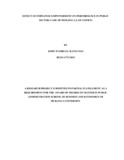| dc.description.abstract | The study assessed the effect of employee empowerment on performance in public sector: case of Murang’a law courts. Judiciary plays a very important role in delivering justice fairly, impartially and expeditiously, while promoting equal access to justice and advancing local jurisprudence by upholding the rule of law (Mutunga, 2012). This mandate has not yet been fully realized. Consequently, the backlog of cases has been increasing. This has been caused by various intervening factors including one of employee- employer relationships among others. The theory to be adopted in conceptualizing the objectives was be guided by Kanter’s structural empowerment theory, which focuses on the structures within the organization rather than individual’s own qualities. The study fitted very well with this theoretical view as the overall objective was to establish the effect of employee empowerment on performance in public sector, case of Murang’a law courts. The specific objectives were to investigate how psychological, role, organizational and embedded empowerment affected reliability, effectiveness, job turnover and job accomplishments respectively. This was as per the conceptual framework (Fig. 1) shown. The research design for this study was qualitative research though with some quantitative data analysis. Target population for this study were be all the fifty two (52) judicially staff. Pre-testing of the data was be done at Kangema Law courts. Primary data was collected using structured questionnaire. This was supplemented by secondary data obtained from judiciary and government published reports. Data analysis involved establishment of categories, application of these categories to raw data through coding, tabulation and then drawing conclusions. The researcher then put the data collected and the findings into a logical and consistent report by employing descriptive statistics as data analysis techniques. These were in form of tables, figures, description charts and percentages where applicable. Findings of the study may contribute to judiciary coming up with better ways of empowering its employees. This will make the judicially reliable, effective, have low job turnover and have high rates in job accomplishment, and lastly aid judiciary in policy reforms to increase efficiency and effectiveness. | en_US |

